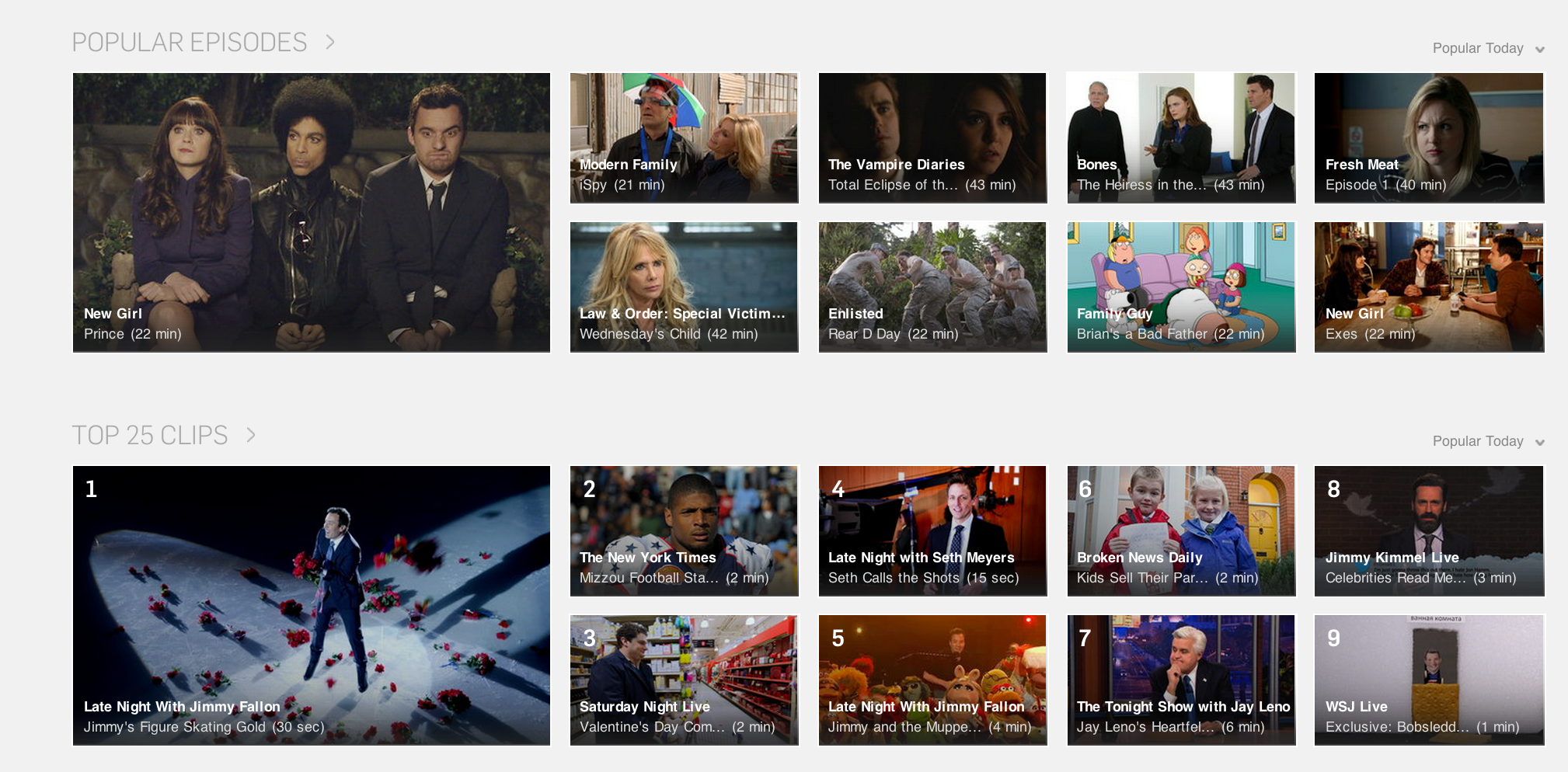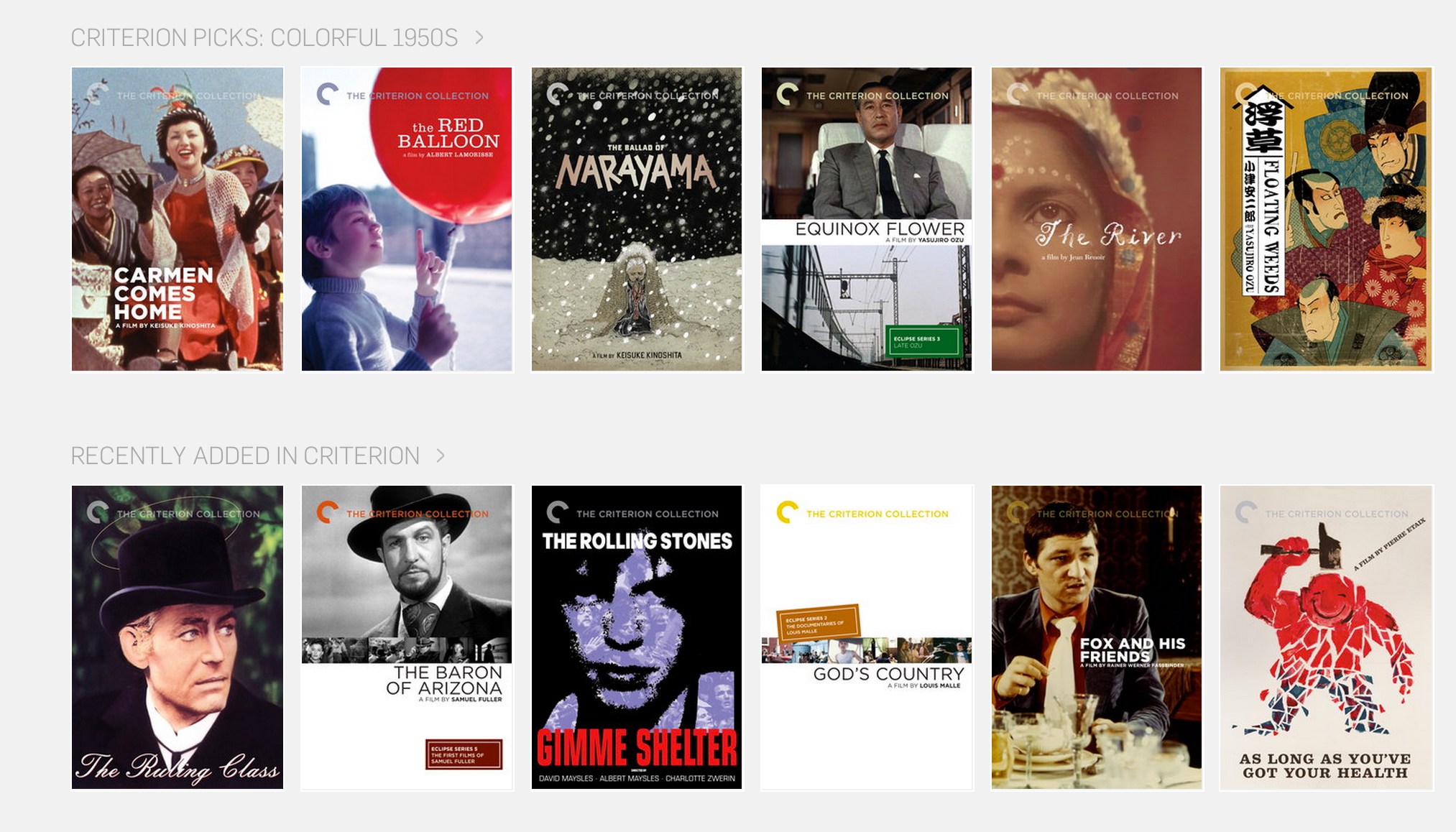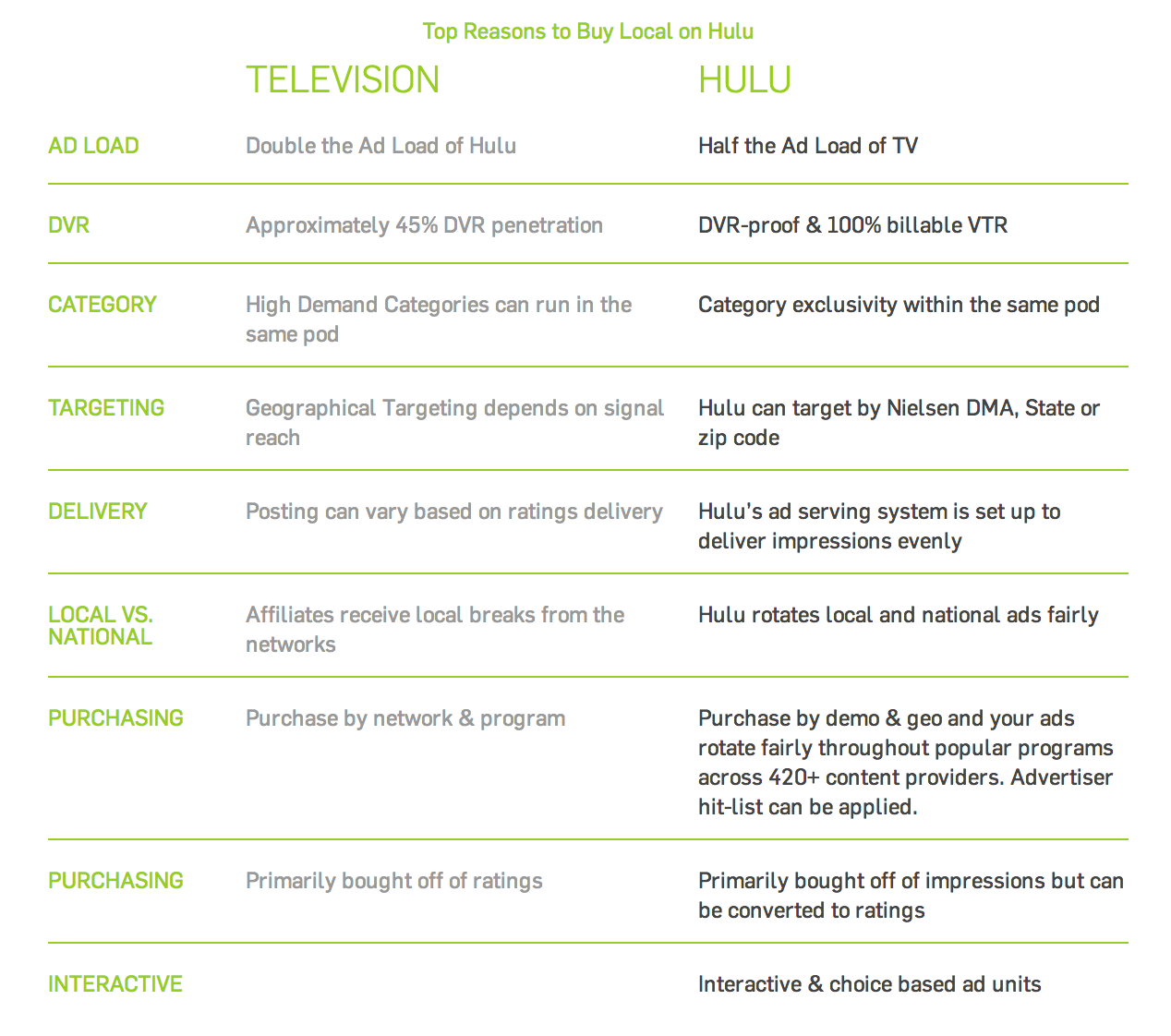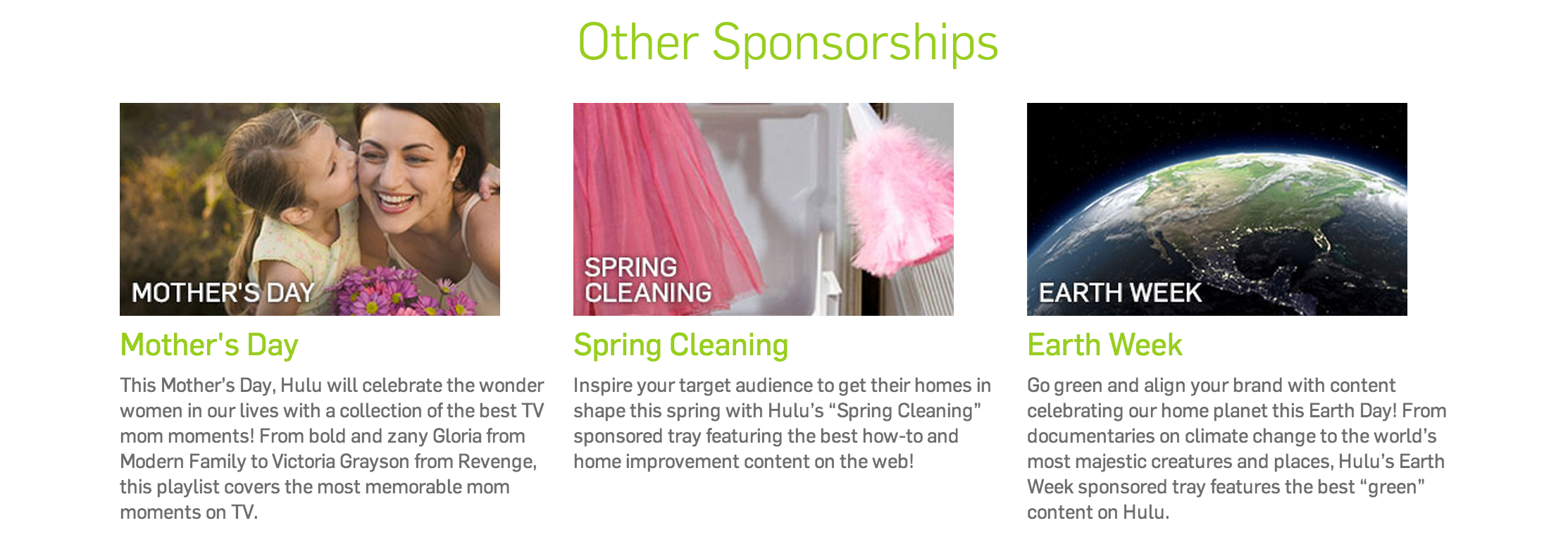Adverstreaming: Hulu Plus
Derek Kompare / Southern Methodist University

In my previous installment in this look at video streaming sites, I discussed how Warner Archive Instant functions as a “cult streamer” in that its content and audience are defined by their market marginality. That is, they explicitly locate themselves within a cultural niche, and capitalize on that position.
The much more prominent subject of this exploration, Hulu, operates primarily on the opposite principle. Whereas WAI offers only a particular range of material for particular viewers, Hulu attempts to offer virtually everything for everybody: preschoolers, Korean drama fans, Criterion film fans, late night talk show fans, classic sitcom fans, anime fans, and most prominently, viewers catching up on current ABC, CW, Fox, and NBC programs. Even among fellow “big-tent” streamers (i.e., on the same tier as Amazon Prime and Netflix), Hulu is unique in the breadth of both its offerings and its organization. While its approach may seem scattershot in an era of increasing cultural niches, it’s clearly been a successful strategy. Most other streamers gather content for users; Hulu, like traditional television, instead gathers users for their advertisers.
Hulu launched on March 12, 2008, a few months after the start of Netflix’s streaming video service, and a couple of years into the broadcast networks’ own streaming efforts on their websites. It ostensibly aimed to channel the new appetite for convenient online video into a venue for advertising, at a hitherto unseen scale and scope. Since that time, Hulu has greatly expanded their utility (adding dozens of Hulu-capable devices, and new interfaces and social functions), and their content (hundreds of thousands of videos from hundreds of distributors). Although Hulu operated at first only as a free-to-user, advertising-supported platform (primarily featuring recent episodes of several broadcast networks’ shows, and an expanding library of older programs), it opened up the subscription tier Hulu Plus in the fall of 2010, which offered a much deeper content library, while still maintaining the accompanying advertisements. In other words, while “free” Hulu operates in a broadcast mold, Hulu Plus is functionally like basic cable.
Despite its overall success, Hulu’s position among streaming platforms is somewhat liminal, given its often discordant corporate parents (whose divisions eventually resulted in the departure of its idealistic founder Jason Kilar in January 2013).1 Its early branding as a gleefully disruptive upstart battling media giants has always been undermined by its simultaneous joint ownership by three of the biggest of those giants: Disney, 21st Century Fox, and Comcast. While Comcast’s stake does not grant them control, as a regulatory condition of their acquisition of NBCUniversal, the other two partners have had disparate visions for Hulu: 21st Century Fox would prefer to focus primarily on developing the paid subscription model, but Disney favors the platform’s advertising function. That said, regardless of the economic model, all three corporations also have deep interests in the vitality of the current cable TV ecosystem. Accordingly, Hulu is never going to become positioned or supported as an alternative to that hegemony. But at the same time it is clearly valuable as an established, accessible platform for distributing content and advertising. Too valuable, indeed, to let go to an outside party (say Yahoo, Apple, or Google) who might not have as much fealty to the cable crown. Thus, plans for both an initial public offering and corporate sale of Hulu have been cancelled on multiple occasions (most recently last summer) when the corporate owners had second thoughts.

Because of this odd marriage, Hulu is apparently both a floor wax and a dessert topping: simultaneously a subscription and advertising-based system. While this combination isn’t novel in the broad history of media platforms–most cable and satellite systems and channels worldwide have long had an identical function–it is still rare among streaming platforms, which have been perceived more along the lines of a premium cable channel: subscriber fees are exchanged for the promise of ad-free programming. According to Hulu’s mission statement, their goal is still a service that “users, advertisers, and content owners unabashedly love.” This tension between pleasing all three of these masters is most visible when one seemingly trumps the other two in particular uses, as when access to content is limited (favoring the content owner), content is (at times, clumsily) broken up by advertising (favoring the advertiser), or content is edited and shared by users with Hulu’s sharing tools (favoring the user). But this is a balance that must be kept in order to maintain the platforms appeal to all parties. As seen in the above sketch I carved out of a 1976 Saturday Night Live episode, even embedded clips contain advertising and promotional cards for their distributors.
While this tension seems at odds with the “pull” interface of Netflix (and the longstanding architecture of the web), it feels right at home with the longstanding “push” architecture of good ol’ television, where advertising is still the currency and the viewer is still the product. As Daniel Chamberlain argues, television interfaces are “gateways to the content we desire…subtly reformatting our televisual experiences along vectors of customization and control.”2 Navigating a Hulu viewing session, particularly from one’s couch, is a close replication of traditional TV channel-surfing.

Most other online streaming platforms dive immediately into your established interests and subscriptions, and offer up titles and categories accordingly. In contrast, Hulu gives only a tiny nod to your specific interests (“Shows you watch”), but then loads the rest of its main page with content categories generated by currency (“Recently Added”), popularity with users (“Trending Now,” “Top 25 Clips”, “Popular Episodes,” “Popular Shows,” “Popular Networks”), or content-owner- or advertiser-sponsored focus (“Sochi Watch,” “Urban Outfitters Presents Hulu’s Best Double Acts,” “Mythbusters Investigates”). You are not the center of this experience, but rather a willing participant in a wider viewing community.
Clicking beyond the main page–the cryptic top-level headings are “TV,” “Movies,” “Kids,” and “More”–at first continues the emphasis on popularity and established genres, but then uncovers the specificity of Hulu’s acquired content: its hidden niches. Thus, while the default emphasis is firmly on television, the primary categories under the “Film” banner are documentaries and the Criterion Collection. Similarly, “More” doesn’t bring up universal categories, but instead culturally-specific ones directly tied to distribution deals with particular content owners: “Latino,” “British,” “Anime,” “Korean Drama,” and “Video Games.”

As deep as its library is, it must be remembered that Hulu’s stated goal is not to be the top niche streamer, but, rather, to be “the world’s most effective video advertising service.”3 Their advertising sales pitch is designed both to reassure dubious advertisers, at every geographic level, of their punch relative to television, and to emphasize the way their site architecture channels viewers to particular market-driven categories (e.g., their rapidly growing Latino content). They offer sponsorship of specific platform-wide events, when particular content is assembled under a themed banner (e.g., coinciding with the turn of seasons, or particular holidays). Their original programming is similarly organized with a rising scale of potential sponsorships, including “Hulu Spotlight” programs (“genetically engineered for advertisers”), and peaking in fully “Brand Authored Content,” like Chipotle’s anti-industrial farming satire, Farmed and Dangerous.4



We can’t know exactly how the detente between Fox and Disney over Hulu has gone, but I suspect that Disney won the argument, waving reams of advertising data. The big content deals have kept on coming, and the bar between “free” and “Plus” content has been adjusted more in favor of the latter. Even CBS, long resistant to streaming their current programming to third parties, has made a rapid series of deals with Hulu, not only for older library series dating back to the 1960s, but for much more recent programs, including Blue Bloods, Elementary, and The Good Wife. Thus, as cable TV quickly refined the advertising basis of broadcast TV, Hulu has continued that logic, offering users, advertisers, and content owners a platform that they might not unabashedly love, but that they certainly like quite a bit.
Image Credits:
1. Screengrab of Hulu website, author generated and owned
2. Screengrab of Hulu website, author generated and owned
3. Screengrab of Hulu website, author generated and owned
4. Screengrab of Hulu website, author generated and owned
5. Screengrab of Hulu website, author generated and owned
Please feel free to comment.
- Jeff Ulin, The Business of Media Distribution (Second Edition). New York: Focal Press, 2013. 404-05. [↩]
- Daniel Chamberlain, “Television Interfaces,” Journal of Popular Film and Television (Summer 2010) 84-88. [↩]
- http://www.hulu.com/advertising/. Accessed February 8, 2014. [↩]
- http://www.hulu.com/advertising/original-programming/. Accessed February 8, 2014. [↩]
One of the things I find most intriguing about Hulu as a service is the return to sponsored television programming. Some percentage of Hulu content (including the SNL link in the article above) includes “sponsored by” intertitles, hearkening back to the network practices in an earlier moment of television history, in which a brand would fund a program in exchange for exposure and guaranteed ad segments. HuluPlus (or at least the version I access through my PS3; I can’t really speak to alternate platforms) puts these sponsorship marks on such diverse content as short “clip” segments of programming and trailers for upcoming films and video games. The first time I watched a movie trailer and was confronted by a sponsorship, I was somewhat confused. Hadn’t I already agreed to be advertised to? Did I need to have additional, involuntary ads thrown at me?
The culmination of this trend, I think, is the program Farmed and Dangerous, an ad for which is also above. This program is a comedy starring Ray Wise (Laura Palmer’s dad!) which satirizes agribusiness practice. The show is apparently funded by the Chipotle Mexican Grill fast food chain, which was once partly owned by McDonalds (a fact in clear contrast with the eco-friendly, local-sourced, organic image the company had long cultivated). Although I have yet to watch the show, plot synopses claim that the program concerns an unscrupulous agribusiness concern that begins creating “petropellets,” an animal feed source made directly from petroleum, leading to dangers to public health. This, to me, makes Farmed and Dangerous a thoroughly and perhaps unpleasantly postmodern product – a show-length advertisement using a combination of humor and co-opted activism to present the illusion of social change and progress. It is, of course, too early to tell if such a model will gain traction in the television marketplace, but it seems, at the least, like a possible alternative.
This use of sponsorship (on top of the normal ad load) is exactly how Hulu can draw even more revenue. Thus, every bit of content (including user-cut clips, as I indicated) has at least three revenue streams: user subscriptions, sponsors, and advertisers (on top of the promotional push given to the owner/distributor of the content itself).
As for Farmed and Dangerous, it’s in keeping with a long, long, long line of such sponsored content (going at least as far back as 1920s radio) using “social message” discourses to promote business. I don’t find this form itself all that revolutionary. Rather, I’m just intrigued by how many revenue streams Hulu can tap into, and how it’s reconstructed very traditional “broadcast” models of advertising, content, and promotion along the way.
Over the last six years in particular, I have noticed more and more that my computer, and Hulu in particular, were becoming more like television. The rate at which information can be accessed and content can be streamed on the Internet exploded shortly before this.
I personally do not use Hulu’s paid service. I have Netflix and cable TV (included in my apartment), and I dislike the inconvenience of advertising interrupting my viewing. The main advantage Hulu has over its competitors (particularly Amazon and Netflix) is that its content is very current. For current programming, I would assume more viewers are willing to live with advertising– as I live with it when I watch my live cable feed. For an extra service that I pay for, such as Netflix, the prospect of commercial interruptions would be enough to keep me from continuing my subscription.
It seems like a redundancy to pay for both Hulu Plus and to have or to pay for cable. This is like having two cables. One is a cable that chooses what I watch, as I mindlessly allow it to wash over me (although some services offer an On-Demand option, which makes Hulu Plus even more redundant). The other is a cable from which I can pick whatever show I like and then binge-watch until all are complete. For both, I have to watch commercials. Why bother?
If I were in a situation where I had to pay for cable TV, I still probably would opt out of both that and Hulu Plus. If I cared enough about a show that I needed to see it every time it aired, I would pay attention to its online release and watch it on Hulu’s free service anyway.
I want to start by saying that this article was both insightful and informative. I don’t have any sort of personal investment in Hulu (as it is not my favorite streaming site), so my knowledge of the site is rather scarce. I used Hulu as an undergraduate, but then quickly stopped after they started moving the better programming to their subscription service, Hulu Plus. To address some of the points raised in the article, I would pose the following question: how much longer can Hulu as an ad-supported online streaming platform retain its status, given the continued dominance of Netflix and the emergence of Amazon Instant Video? While Hulu does offer content that is much more current than perhaps the content on Netflix or Amazon, but part of the success of Netflix is the ability to binge watch a program without the burden of commercials. What irritates me about Hulu is the fact that it’s an online streaming service that gives users the option to subscribe for a fee, but still has the nerve to incorporate commercials. Online streaming is not readily associated with commercials, yet Hulu has found a way to remain successful as an online streaming website that just happens to include commercials.
If Hulu functions similar to both the broadcast and basic cable model, than Netflix would be the equivalent of premium cable (HBO, Cinemax, Showtime). Hulu is “simultaneously a subscription and advertising-based system” that aims to become “the world’s most effective video advertising service,” but how long can this model last? It’s interesting to note that Hulu and Netflix launched around the same time, but are the websites really in competition with each other? Hulu does focus more on television content as opposed to films, which is not surprising given the fact that Hulu is partially owned by Disney, 21st Century Fox, and Comcast.
I personally would much rather pay for a cable subscription that includes a DVR than a subscription to Hulu Plus because despite Hulu’s vast library, cable still offers much more content than Hulu. And Hulu’s content is very much associated with broadcast television networks. Hulu provides programming from networks such as ABC, NBC, FOX, and the CW, but why would someone pay $7.99 a month to watch broadcast shows on Hulu when they can watch the same shows on the network’s website? Of course, the network website will only have a new episode of a show available for a week or so, which does not really provide the opportunity to binge watch or catch up on episodes, but the content is still free.
I question the future of a an ad-supported streaming system like Hulu because cable companies are now adapting to the capabilities of streaming services by offering customers some of the same privileges. For example, I currently have a cable subscription with DIRECTV that includes a DVR which can record up to five shows at once and can hold over a hundred hours of programming. This isn’t even the best part…I just received a new device from DIRECTV called GenieGo that allows me to access my recorded DVR content anywhere with Wi-Fi, but also live stream anything on television. As devices such as these become more popular, more accessible and more affordable, will ad-supported services such as Hulu struggle to compete? Of course cable is more costly than Hulu, but I don’t have to wait 24 hours to watch a program and I can bypass any and all commercials. This might not be a sufficient reason for most people to cancel their Hulu Plus subscriptions and convert to cable, yet it still poses significant questions about the future viability and perseverance of a website like Hulu. I do believe that Hulu will remain profitable as long as it can continue to offer current and cheap programming, but I also believe that Hulu has to eventually offer users something more if the website wishes to remain relevant and successful.